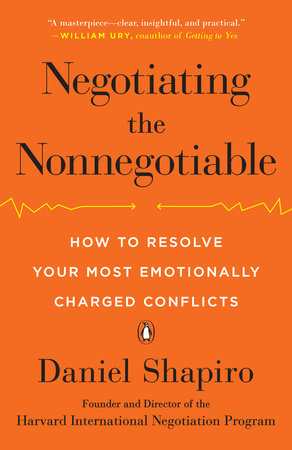Negotiating the Nonnegotiable:
4 Keys to Resolving Conflict
with Your Kid
by Daniel Shapiro, Ph.D.
Every parent knows the nightly ritual: You read your child a bedtime story, say “lights out,” and then brace for the storm of “I do not want to go to bed!!!” Night after night, we parents all suffer from this same malady, until we finally lose that last sliver of patience and snap back at our child with some not-so-nice words. Our child eventually falls asleep, but we lay awake worrying about what we said and wondering whether we may just be the single worst parent in the world.
You’re not. In reality, every parent and child fights — and a whole new set of tools offers powerful methods to resolve conflict, whether you are struggling to put your four-year-old to sleep or tussling with your teenager over screen time. Here are four crucial guidelines:
1. Don’t fall into “vertigo.” Perhaps no relationship in life is as intense as that between parent and child. So as conflict intensifies, you risk having the tension emotionally consume you, to the extent that you can think of nothing else in your life. I call this experience vertigo, for you feel like the world is spinning out of control. Every time you try to regain focus, your child makes a new demand of you or a child lobs a punch at a sibling, pulling you one step further into that emotional swirl.
The best way to break out of vertigo is to avoid getting into it. As tensions escalate, ask yourself one critical question: “Do I really want to get caught up in this conflict?” Most likely, the answer will be no. So take a moment to regain perspective: Take a deep breath and imagine yourself an hour from now, alone in the shower or in your bed relaxing and reading a book. Or imagine yourself on the moon looking down at your interaction. Is it really worth getting so worked up over your kid’s bedtime? Probably not.
2. Appreciate your child’s concerns. We parents tend to think that we know all the right answers, especially when we are in arguments with our children. But just because we have power over our kids doesn’t mean that there is no validity to their perspectives. Kids often have a good rationale motivating their behavior, and it pays to take the time to inquire, listen, and try to understand. When your ten-year-old starts shouting that you treat him unfairly, don’t just defend your behavior. Ask why he thinks that way. He may be jealous of the leniency you show in disciplining his younger brothers, or he may be making a call for more attention.
3. Give your child some autonomy. Imagine how disempowering it can feel to be a child: Your parents tell you what time to wake up, what to eat, when to sleep, and even how to talk. Unsurprisingly, then, children want some freedom to determine their own destiny. Even my four-year-old son Liam will break out in a temper tantrum if I choose his dessert for him. “Daddy! I want to choose!!!” So the next time your child asks if she can stay up an extra half hour, don’t just say no. Ask why. Listen to her reason, and give her a choice: “If you stay up later tonight, you will have to go to bed earlier tomorrow night. Which do you want?”
4. Resist the repetition compulsion. Notice the patterns of conflict that you tend to repeat when in a fight with a child. In my own family, I noticed a common pattern develop with my ten-year-old son, Noah. The moment he started to tease his younger brothers, I would immediately step in with tough words: “Noah … stop!” He tended to ignore those words and persist with his behavior, which undermined my authority but elevated his status in his brothers’ eyes. Of course, I would then further assert my authority, again demanding he stop. Inevitably, our conversation would end in a verbal clash.
But our relationship was not doomed. The key is to notice a dysfunctional pattern of conflict and commit to changing one or two actions in that process. In my relationship with Noah, I came to understand our typical pattern of mutual confrontation, and I sought to change my behavior. When Noah next teased his brothers, I stepped in and asked him to stop. He refused. But instead of escalating my demand, I asked his advice on how we might deal with the situation. He appeared caught off guard, and told me that his younger brothers had been invading his space on the couch. Now we were talking, listening, and effectively communicating. By asking Noah for advice, I jolted us out of our typical pattern of discord, which created space for us to have a more productive conversation.
So take action today, tomorrow, and the next.
As I write this article, I realize that the advice I am sharing is as much for me as for you. My three boys are loving and adorable, but they certainly test their daddy’s patience on a daily basis. Patterns of conflict are hard to change. But with conscientious effort, you can avoid falling prey to vertigo, to the repetition compulsion, and to the usual fight. As you keep trying, your fights will start to feel more manageable, and your relationships will feel more constructive. And with enough effort, you may just be able to master the fine art of conflict resolution by the time your child grows up.
To discover additional practical tools for resolving your life’s toughest conflicts– whether with your children, spouse, or colleagues — check out Dr. Shapiro’s newest book, Negotiating the Nonnegotiable: How to Resolve your Most Emotionally Charged Conflicts (Viking, 2016).
-
Negotiating the Nonnegotiable: How to Resolve your Most Emotionally Charged Conflicts
Available from:Also available from:

